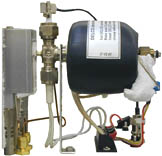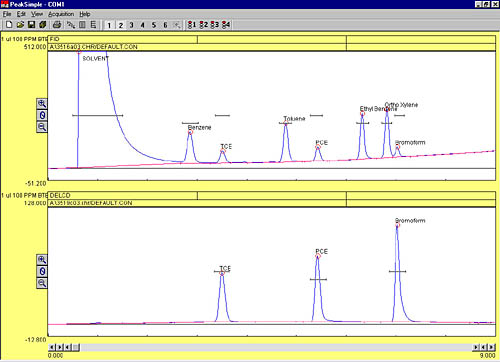|
FID/DELCD
Combination Detector
|
43
|
|
 |
The FID/DELCD is one of the most useful detector combinations because it allows the operator to reliably identify hydrocarbon peaks detected by the FID as halogenated or not.
While less sensitive than the ECD detector, the DELCD is much more selective, eliminating interferences which would complicate an ECD analysis (such as ambient oxygen). Sample preparation which might be required for ECD work is not required for the DELCD because of its total selectivity to chlorine and bromine, and because the FID pre-combusts any contaminants. In the high sensitivity mode (hydrogen off, using dry cylinder air), the DELCD can detect down to the low picogram range. In this mode, the DELCD is about 100 times more sensitive than when used with the FID in low sensitivity mode.
The DELCD measures the ClO2 present in the FID exhaust gas. Because the FID combusts the sample upstream of the DELCD, all hydrocarbons are comverted to CO2 prior to the DELCD, thereby preventing large hydrocarbon peaks from contaminating the DELCD. Since the DELCD operates at close to 1000oC, it can tolerate the water-saturated FID effluent and measure the chlorine and bromine content simultaneously with the FID hydrocarbon content measurement. This is especially useful for measuring chlorinated VOCs under a solvent peak, or measuring PCB peaks obscured under large amounts of diesel fuel. This detector combination is often used with our Thermal Desorber and Purge & Trap, which concentrate the sample to achieve lower detection limits (see our pre-configured PCB GC system on page 19).
The FID/DELCD is supplied with dual amplifiers and comes with a spare DELCD detector assembly.
| The top FID trace shows the hydrocarbons in a 100ppm BTEX + bromoform sample, while the bottom DELCD trace shows only the halogenated compounds. The DELCD completely rejects the large solvent peak. |  |
|
8690-2026
|
FID/DELCD
combination detector
|
£4,544.00
|
|||
|
FID/DELCD
Combination Detector
|
43
|